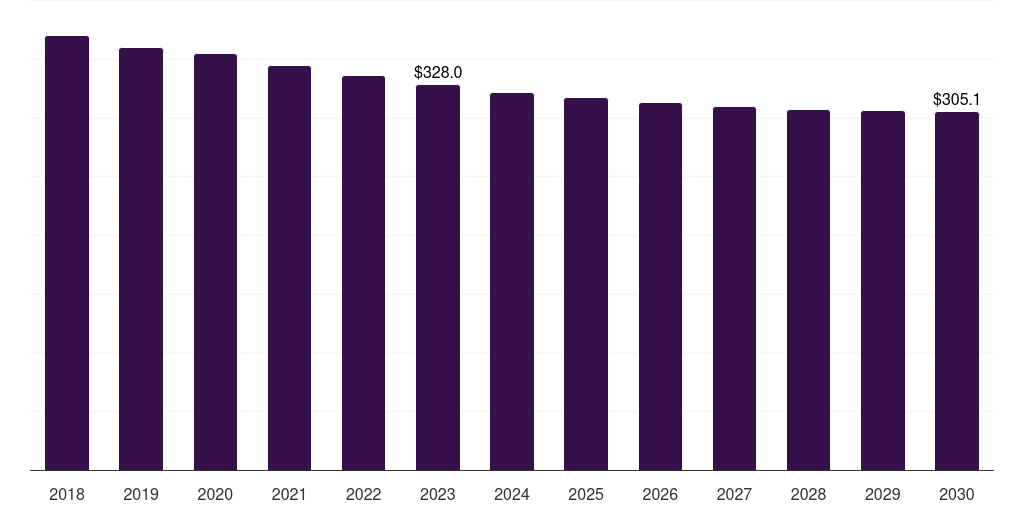Russia Cancer Supportive Care Drugs Market Size & Outlook
Russia cancer supportive care drugs market, 2018-2030 (US$M)

Related Markets
Russia cancer supportive care drugs market highlights
- The Russia cancer supportive care drugs market generated a revenue of USD 328.0 million in 2023 and is expected to reach USD 305.1 million by 2030.
- The Russia market is expected to grow at a CAGR of -1% from 2024 to 2030.
- In terms of segment, opioids was the largest revenue generating therapeutic class in 2023.
- NSAIDs and Others is the most lucrative therapeutic class segment registering the fastest growth during the forecast period.
Cancer supportive care drugs market data book summary
| Market revenue in 2023 | USD 328.0 million |
| Market revenue in 2030 | USD 305.1 million |
| Growth rate | -1% (CAGR from 2023 to 2030) |
| Largest segment | Opioids |
| Fastest growing segment | NSAIDs and Others |
| Historical data | 2018 - 2022 |
| Base year | 2023 |
| Forecast period | 2024 - 2030 |
| Quantitative units | Revenue in USD million |
| Market segmentation | G-CSFs (Granulocyte-colony Stimulating Factors), ESAs (Erythropoiesis Stimulating Agents), Antiemetics, Bisphosphonates, Opioids, NSAIDs and Others |
| Key market players worldwide | Amgen Inc, Merck & Co Inc, Johnson & Johnson, Heron Therapeutics Inc, Novartis AG ADR, GSK PLC, Roche Holding AG ADR, Helsinn Healthcare |
Other key industry trends
- In terms of revenue, Russia accounted for 2.5% of the global cancer supportive care drugs market in 2023.
- Country-wise, U.S. is expected to lead the global market in terms of revenue in 2030.
- In Europe, Germany cancer supportive care drugs market is projected to lead the regional market in terms of revenue in 2030.
- Russia is the fastest growing regional market in Europe and is projected to reach USD 305.1 million by 2030.
No credit card required*
Horizon in a snapshot
- 30K+ Global Market Reports
- 120K+ Country Reports
- 1.2M+ Market Statistics
- 200K+ Company Profiles
- Industry insights and more
Cancer Supportive Care Drugs Market Scope
Cancer Supportive Care Drugs Market Companies
| Name | Profile | # Employees | HQ | Website |
|---|
Russia cancer supportive care drugs market outlook
The databook is designed to serve as a comprehensive guide to navigating this sector. The databook focuses on market statistics denoted in the form of revenue and y-o-y growth and CAGR across the globe and regions. A detailed competitive and opportunity analyses related to cancer supportive care drugs market will help companies and investors design strategic landscapes.
Opioids was the largest segment with a revenue share of 25.95% in 2023. Horizon Databook has segmented the Russia cancer supportive care drugs market based on g-csfs (granulocyte-colony stimulating factors), esas (erythropoiesis stimulating agents), antiemetics, bisphosphonates, opioids, nsaids and others covering the revenue growth of each sub-segment from 2018 to 2030.
The incidence of cancer in the country is increasing. As per GLOBOCAN, the number of new cancer cases in Russia was 591,000 in 2020, which is expected to increase to 645,000 by 2030. Chemotherapy and radiation therapy are still commonly used for treatment of various types of cancer.
Large number of adverse effects associated with usage of traditional chemotherapy and radiation therapy is driving market growth. According to an article, the most commonly observed disease and treatment-related symptoms in gastric cancer patients after second line treatment include nausea/ vomiting in 75% patients and pain in around 74% patients.
According to the same article, antiemetics (~63%) and narcotic analgesics (~48%) were the most commonly used supportive care options. Rising penetration of biosimilars and declining prescription rates for opioids & ESAs are expected to impede market growth.
Reasons to subscribe to Russia cancer supportive care drugs market databook:
-
Access to comprehensive data: Horizon Databook provides over 1 million market statistics and 20,000+ reports, offering extensive coverage across various industries and regions.
-
Informed decision making: Subscribers gain insights into market trends, customer preferences, and competitor strategies, empowering informed business decisions.
-
Cost-Effective solution: It's recognized as the world's most cost-effective market research database, offering high ROI through its vast repository of data and reports.
-
Customizable reports: Tailored reports and analytics allow companies to drill down into specific markets, demographics, or product segments, adapting to unique business needs.
-
Strategic advantage: By staying updated with the latest market intelligence, companies can stay ahead of competitors, anticipate industry shifts, and capitalize on emerging opportunities.
Target buyers of Russia cancer supportive care drugs market databook
-
Our clientele includes a mix of cancer supportive care drugs market companies, investment firms, advisory firms & academic institutions.
-
30% of our revenue is generated working with investment firms and helping them identify viable opportunity areas.
-
Approximately 65% of our revenue is generated working with competitive intelligence & market intelligence teams of market participants (manufacturers, service providers, etc.).
-
The rest of the revenue is generated working with academic and research not-for-profit institutes. We do our bit of pro-bono by working with these institutions at subsidized rates.
Horizon Databook provides a detailed overview of country-level data and insights on the Russia cancer supportive care drugs market , including forecasts for subscribers. This country databook contains high-level insights into Russia cancer supportive care drugs market from 2018 to 2030, including revenue numbers, major trends, and company profiles.
Partial client list
Russia cancer supportive care drugs market size, by therapeutic class, 2018-2030 (US$M)
Russia Cancer Supportive Care Drugs Market Outlook Share, 2023 & 2030 (US$M)
Related industry reports
Related regional statistics
No records
No related regions found.
Sign up - it's easy, and free!
Sign up and get instant basic access to databook, upgrade
when ready, or enjoy our
free plan indefinitely.
Included in Horizon account
- 30K+ Global Market Reports
- 120K+ Country Reports
- 1.2M+ Market Statistics
- 200K+ Company Profiles
- Industry insights and more



